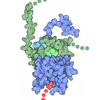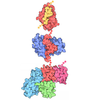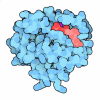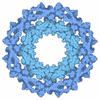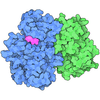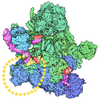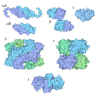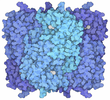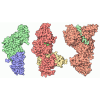+ Open data
Open data
- Basic information
Basic information
| Entry | Database: PDB / ID: 7tzo | ||||||
|---|---|---|---|---|---|---|---|
| Title | The apo structure of human mTORC2 complex | ||||||
 Components Components |
| ||||||
 Keywords Keywords | SIGNALING PROTEIN / complex | ||||||
| Function / homology |  Function and homology information Function and homology informationRNA polymerase III type 2 promoter sequence-specific DNA binding / RNA polymerase III type 1 promoter sequence-specific DNA binding / positive regulation of cytoplasmic translational initiation / regulation of locomotor rhythm / T-helper 1 cell lineage commitment / positive regulation of pentose-phosphate shunt / positive regulation of wound healing, spreading of epidermal cells / regulation of phosphatidylinositol 3-kinase/protein kinase B signal transduction / TORC2 signaling / TORC2 complex ...RNA polymerase III type 2 promoter sequence-specific DNA binding / RNA polymerase III type 1 promoter sequence-specific DNA binding / positive regulation of cytoplasmic translational initiation / regulation of locomotor rhythm / T-helper 1 cell lineage commitment / positive regulation of pentose-phosphate shunt / positive regulation of wound healing, spreading of epidermal cells / regulation of phosphatidylinositol 3-kinase/protein kinase B signal transduction / TORC2 signaling / TORC2 complex / regulation of membrane permeability / cellular response to leucine starvation / negative regulation of lysosome organization / heart valve morphogenesis / TFIIIC-class transcription factor complex binding / TORC1 complex / voluntary musculoskeletal movement / positive regulation of transcription of nucleolar large rRNA by RNA polymerase I / regulation of cellular response to oxidative stress / calcineurin-NFAT signaling cascade / RNA polymerase III type 3 promoter sequence-specific DNA binding / positive regulation of keratinocyte migration / regulation of osteoclast differentiation / regulation of lysosome organization / MTOR signalling / cellular response to L-leucine / energy reserve metabolic process / regulation of autophagosome assembly / Energy dependent regulation of mTOR by LKB1-AMPK / cellular response to nutrient / phosphatidic acid binding / Amino acids regulate mTORC1 / TORC1 signaling / negative regulation of Ras protein signal transduction / serine/threonine protein kinase complex / embryo development ending in birth or egg hatching / ruffle organization / cellular response to methionine / phosphatidylinositol-3,4-bisphosphate binding / negative regulation of cell size / positive regulation of ubiquitin-dependent protein catabolic process / cellular response to osmotic stress / phosphatidylinositol-3,5-bisphosphate binding / negative regulation of protein localization to nucleus / anoikis / inositol hexakisphosphate binding / cardiac muscle cell development / negative regulation of calcineurin-NFAT signaling cascade / regulation of myelination / positive regulation of transcription by RNA polymerase III / regulation of establishment of cell polarity / negative regulation of macroautophagy / Macroautophagy / lipid biosynthetic process / positive regulation of myotube differentiation / regulation of cell size / Constitutive Signaling by AKT1 E17K in Cancer / positive regulation of actin filament polymerization / germ cell development / phosphatidylinositol-3,4,5-trisphosphate binding / behavioral response to pain / TOR signaling / oligodendrocyte differentiation / positive regulation of oligodendrocyte differentiation / mTORC1-mediated signalling / positive regulation of translational initiation / CD28 dependent PI3K/Akt signaling / HSF1-dependent transactivation / regulation of macroautophagy / positive regulation of TOR signaling / enzyme-substrate adaptor activity / response to amino acid / 'de novo' pyrimidine nucleobase biosynthetic process / positive regulation of epithelial to mesenchymal transition / vascular endothelial cell response to laminar fluid shear stress / positive regulation of lipid biosynthetic process / heart morphogenesis / cellular response to nutrient levels / neuronal action potential / regulation of cellular response to heat / positive regulation of lamellipodium assembly / cardiac muscle contraction / T cell costimulation / positive regulation of stress fiber assembly / phagocytic vesicle / positive regulation of endothelial cell proliferation / phosphatidylinositol-4,5-bisphosphate binding / endomembrane system / cytoskeleton organization / substantia nigra development / negative regulation of insulin receptor signaling pathway / negative regulation of autophagy / cellular response to amino acid starvation / regulation of signal transduction by p53 class mediator / positive regulation of glycolytic process / cellular response to starvation / positive regulation of translation / protein serine/threonine kinase activator activity / Regulation of PTEN gene transcription / VEGFR2 mediated vascular permeability Similarity search - Function | ||||||
| Biological species |  Homo sapiens (human) Homo sapiens (human) | ||||||
| Method | ELECTRON MICROSCOPY / single particle reconstruction / cryo EM / Resolution: 3.28 Å | ||||||
 Authors Authors | Yu, Z. / Chen, J. / Pearce, D. | ||||||
| Funding support |  United States, 1items United States, 1items
| ||||||
 Citation Citation |  Journal: J Biol Chem / Year: 2022 Journal: J Biol Chem / Year: 2022Title: Interactions between mTORC2 core subunits Rictor and mSin1 dictate selective and context-dependent phosphorylation of substrate kinases SGK1 and Akt. Authors: Zanlin Yu / Junliang Chen / Enzo Takagi / Feng Wang / Bidisha Saha / Xi Liu / Lydia-Marie Joubert / Catherine E Gleason / Mingliang Jin / Chengmin Li / Carlos Nowotny / David Agard / Yifan ...Authors: Zanlin Yu / Junliang Chen / Enzo Takagi / Feng Wang / Bidisha Saha / Xi Liu / Lydia-Marie Joubert / Catherine E Gleason / Mingliang Jin / Chengmin Li / Carlos Nowotny / David Agard / Yifan Cheng / David Pearce /  Abstract: Mechanistic target of rapamycin complex 2 (mTORC2) is a multi-subunit kinase complex, central to multiple essential signaling pathways. Two core subunits, Rictor and mSin1, distinguish it from the ...Mechanistic target of rapamycin complex 2 (mTORC2) is a multi-subunit kinase complex, central to multiple essential signaling pathways. Two core subunits, Rictor and mSin1, distinguish it from the related mTORC1 and support context-dependent phosphorylation of its substrates. mTORC2 structures have been determined previously; however, important questions remain, particularly regarding the structural determinants mediating substrate specificity and context-dependent activity. Here, we used cryo-EM to obtain high-resolution structures of the human mTORC2 apo-complex in the presence of substrates Akt and SGK1. Using functional assays, we then tested predictions suggested by substrate-induced structural changes in mTORC2. For the first time, we visualized in the apo-state the side chain interactions between Rictor and mTOR that sterically occlude recruitment of mTORC1 substrates and confer resistance to the mTORC1 inhibitor rapamycin. Also in the apo-state, we observed that mSin1 formed extensive contacts with Rictor via a pair of short α-helices nestled between two Rictor helical repeat clusters, as well as by an extended strand that makes multiple weak contacts with Rictor helical cluster 1. In co-complex structures, we found that SGK1, but not Akt, markedly altered the conformation of the mSin1 N-terminal extended strand, disrupting multiple weak interactions while inducing a large rotation of mSin1 residue Arg-83, which then interacts with a patch of negatively charged residues within Rictor. Finally, we demonstrate mutation of Arg-83 to Ala selectively disrupts mTORC2-dependent phosphorylation of SGK1, but not of Akt, supporting context-dependent substrate selection. These findings provide new structural and functional insights into mTORC2 specificity and context-dependent activity. | ||||||
| History |
|
- Structure visualization
Structure visualization
| Structure viewer | Molecule:  Molmil Molmil Jmol/JSmol Jmol/JSmol |
|---|
- Downloads & links
Downloads & links
- Download
Download
| PDBx/mmCIF format |  7tzo.cif.gz 7tzo.cif.gz | 1.3 MB | Display |  PDBx/mmCIF format PDBx/mmCIF format |
|---|---|---|---|---|
| PDB format |  pdb7tzo.ent.gz pdb7tzo.ent.gz | 1 MB | Display |  PDB format PDB format |
| PDBx/mmJSON format |  7tzo.json.gz 7tzo.json.gz | Tree view |  PDBx/mmJSON format PDBx/mmJSON format | |
| Others |  Other downloads Other downloads |
-Validation report
| Summary document |  7tzo_validation.pdf.gz 7tzo_validation.pdf.gz | 1.2 MB | Display |  wwPDB validaton report wwPDB validaton report |
|---|---|---|---|---|
| Full document |  7tzo_full_validation.pdf.gz 7tzo_full_validation.pdf.gz | 1.4 MB | Display | |
| Data in XML |  7tzo_validation.xml.gz 7tzo_validation.xml.gz | 198 KB | Display | |
| Data in CIF |  7tzo_validation.cif.gz 7tzo_validation.cif.gz | 296.2 KB | Display | |
| Arichive directory |  https://data.pdbj.org/pub/pdb/validation_reports/tz/7tzo https://data.pdbj.org/pub/pdb/validation_reports/tz/7tzo ftp://data.pdbj.org/pub/pdb/validation_reports/tz/7tzo ftp://data.pdbj.org/pub/pdb/validation_reports/tz/7tzo | HTTPS FTP |
-Related structure data
| Related structure data | 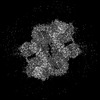 26213MC M: map data used to model this data C: citing same article ( |
|---|---|
| Similar structure data | Similarity search - Function & homology  F&H Search F&H Search |
- Links
Links
- Assembly
Assembly
| Deposited unit | 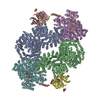
|
|---|---|
| 1 |
|
- Components
Components
| #1: Protein | Mass: 302330.406 Da / Num. of mol.: 2 Source method: isolated from a genetically manipulated source Source: (gene. exp.)  Homo sapiens (human) / Gene: MTOR, FRAP, FRAP1, FRAP2, RAFT1, RAPT1 / Production host: Homo sapiens (human) / Gene: MTOR, FRAP, FRAP1, FRAP2, RAFT1, RAPT1 / Production host:  Homo sapiens (human) Homo sapiens (human)References: UniProt: P42345, non-specific serine/threonine protein kinase #2: Protein | Mass: 37998.254 Da / Num. of mol.: 2 Source method: isolated from a genetically manipulated source Source: (gene. exp.)  Homo sapiens (human) / Gene: MLST8, GBL, LST8 / Production host: Homo sapiens (human) / Gene: MLST8, GBL, LST8 / Production host:  Homo sapiens (human) / References: UniProt: Q9BVC4 Homo sapiens (human) / References: UniProt: Q9BVC4#3: Protein | Mass: 193846.328 Da / Num. of mol.: 2 Source method: isolated from a genetically manipulated source Source: (gene. exp.)  Homo sapiens (human) / Gene: RICTOR, KIAA1999 / Production host: Homo sapiens (human) / Gene: RICTOR, KIAA1999 / Production host:  Homo sapiens (human) / References: UniProt: Q6R327 Homo sapiens (human) / References: UniProt: Q6R327#4: Protein | Mass: 60732.328 Da / Num. of mol.: 2 Source method: isolated from a genetically manipulated source Source: (gene. exp.)  Homo sapiens (human) / Gene: MAPKAP1, MIP1, SIN1 / Production host: Homo sapiens (human) / Gene: MAPKAP1, MIP1, SIN1 / Production host:  Homo sapiens (human) / References: UniProt: Q9BPZ7 Homo sapiens (human) / References: UniProt: Q9BPZ7 |
|---|
-Experimental details
-Experiment
| Experiment | Method: ELECTRON MICROSCOPY |
|---|---|
| EM experiment | Aggregation state: 3D ARRAY / 3D reconstruction method: single particle reconstruction |
- Sample preparation
Sample preparation
| Component | Name: apostate of mTORC2 complex, composed of mTOR, Rictor, mLST8 and mSin1 Type: COMPLEX / Entity ID: all / Source: RECOMBINANT |
|---|---|
| Source (natural) | Organism:  Homo sapiens (human) Homo sapiens (human) |
| Source (recombinant) | Organism:  Homo sapiens (human) Homo sapiens (human) |
| Buffer solution | pH: 7.5 |
| Specimen | Conc.: 1 mg/ml / Embedding applied: NO / Shadowing applied: NO / Staining applied: NO / Vitrification applied: YES |
| Specimen support | Grid material: GOLD / Grid mesh size: 300 divisions/in. / Grid type: Homemade |
| Vitrification | Instrument: FEI VITROBOT MARK IV / Cryogen name: ETHANE / Humidity: 100 % / Chamber temperature: 22 K |
- Electron microscopy imaging
Electron microscopy imaging
| Experimental equipment |  Model: Titan Krios / Image courtesy: FEI Company |
|---|---|
| Microscopy | Model: FEI TITAN KRIOS |
| Electron gun | Electron source:  FIELD EMISSION GUN / Accelerating voltage: 300 kV / Illumination mode: FLOOD BEAM FIELD EMISSION GUN / Accelerating voltage: 300 kV / Illumination mode: FLOOD BEAM |
| Electron lens | Mode: BRIGHT FIELD / Nominal defocus max: 2000 nm / Nominal defocus min: 1000 nm |
| Image recording | Electron dose: 60 e/Å2 / Film or detector model: GATAN K3 (6k x 4k) |
- Processing
Processing
| CTF correction | Type: NONE |
|---|---|
| 3D reconstruction | Resolution: 3.28 Å / Resolution method: FSC 0.143 CUT-OFF / Num. of particles: 288538 / Symmetry type: POINT |
 Movie
Movie Controller
Controller





 PDBj
PDBj